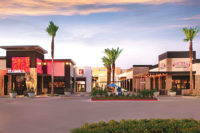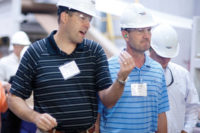
Application
of second taping coat in circular recess.
Fast Arch of America began in Darrell Lilly’s garage more than 15 years ago. Now, its operations have grown substantially and although the bulk of its work is within greater Phoenix, the product is being sent throughout the states and several franchises have been set up.
The concept of Fast Arch began in the early ’90s, when Lilly was working as a builder. One day on the job site, he saw his framer creating an arch. Noticing how long it took this person to create the arch, Lilly told him not to make anymore. That night, he went to his garage, where he had a welder and cutter, and made up an arch. He brought it to the site the next day and installed the product in just a few minutes.
“The person we were building it for asked if I had a patent for it and I said ‘No, you can’t patent an arch.’ But he said I could patent the process so I started that same night. I got it patented in 1997,” says Lilly, president of the company.

L
to R : Chris Estrada and Gary Eatinger of Performance Drywall with Fast Arch of
America’s Darrel Lilly.
Fast Arch actually went into business full time before the patent because Lilly’s attorney told him to get it out there in the market. The company’s array of products have expanded and currently includes: arches, dome ceilings, groin ceilings, radiused wall products, trick ceilings, corbels, special curved range hoods, special straight metal and non-combustible chimney crowns. The company rarely does finished products.
“Most everything is for the framing stage, to usually be covered by drywall or lath/stucco,” says Lilly. “We provide perfect components for these products to be attached to, so the end product can be as near perfect as possible. The installer of Fast Arch Products is assured of not having to be involved in the battle of who is going to pay the nasty back-charge for tear-out, rebuild, re-drywall, and re-paint.”

Installation
of barrel ribbons to give definition to the barrel ceiling.
The St. Clare of Assisi Roman Catholic Church, which is to open in the spring, contacted Fast Arch and wanted to know about its products, what it could offer and more information about the ceiling in its church.
“I got a call from the Diocese’s properties manager who wanted to know if we could build domes or vaulted ceilings. He told me about this project and who was building it. I sent him a catalog and had a short meeting with him, then I met with the general contractor Rowland Construction, who was having some problems trying to figure out what to do with the ceilings. He asked me if we could build and install this and I said yes, we can build it, but no-I can’t install something this big but I know someone who can. So I recommended they use Performance Drywall, who I have worked with for 14 years. Rowland got a complete package price to do this-not just our product installation, but framing, drywall, tape, and texture. When Performance used our products for the framing, it saved the church about $60,000 and they wound up with a product that is perfect.”
Lilly says not only did it save the church enormously up-front, but cut an estimated four to six weeks off the construction schedule. Another drywall company that placed a bid was going to hand-form the pieces on the job site. Lilly says that method would’ve taken four to six weeks to create the vaults and domes and would not be up to the standard of what St. Clare’s needed.
Performance Drywall, of Gilbert, Ariz., landed the contract for drywall and ceiling installation and began its work in June. The scope of the job for the drywall contractor was to frame 100 percent using Western Steel’s metal framing and Pabco’s drywall.
“We framed it with metal studs and put in all the barrel vaults, domes, and the ribbon groins,” says Gary Eatinger, president of Performance. “My guys and Fast Arch made sure we got all the right radiuses together. We drywalled and then applied a Level 5 finish.”

Application
of Level 5 finish on perfectly formed arches
Because the church is local to the manufacturer, Fast Arch was able to deliver its loads; approximately 16,000 pounds of curved metal product, directly to the job site. Eatinger says once the Fast Arch products arrived, Fast Arch staff worked with Performance to assist in the installation, bringing together a components chart to show how everything fit together.
To avoid mistakes, Fast Arch would cut a sample piece to make sure it was zeroed in. The company didn’t want to replicate a mistake if one was made. Lilly says although the project was very complicated, once Fast Arch knew what was needed, the parts just flew out of the shop. None of the pieces had ever been cut before by the company (currently it has more than 6,000 designs in its CAD program) but that was not a problem. Lilly says it only takes minutes to draw up a design and just minutes to cut on the 26-foot-by-5-foot plasma tables.
Altogether, Lilly says the company supplied about 12 different designs, including arches, domes and special ribbon ceilings.
“The most difficult aspect of the job from the technical side was fabricating certain parts that curved on the three axis points, X, Y and Z. We did this without ever having to ‘kink’ the metal or the installers having to ‘notch’ the component,” says Lilly. “That unique layout was done by Ed Lutz, using AutoCAD. The layout was then exported to the plasma tables to be cut and labeled exactly. The cut components had to be assembled in an exact sequence/configuration by the welders before being shipped to the job site. All of this had to happen while under pressure to keep on schedule with the installers. We didn’t have time to make a mistake and then try to correct it.”
As of December, Fast Arch has shipped the last of its material to Performance and Performance wrapped up the installation of the products. The two companies have worked together 14 years and have worked out a system that seems to complement one another.
“The absolute need for 100 percent coordination between Fast Arch, Performance, and the general contractor was made so that we weren’t stepping on other people’s toes. I had to make sure the material was available so we bought some new machinery so there was no chance of downtime,” says Lilly. He is confident that this project will land him more work with Rowland and the Church.



